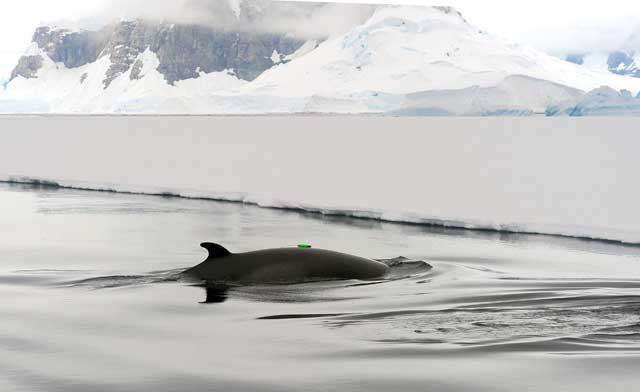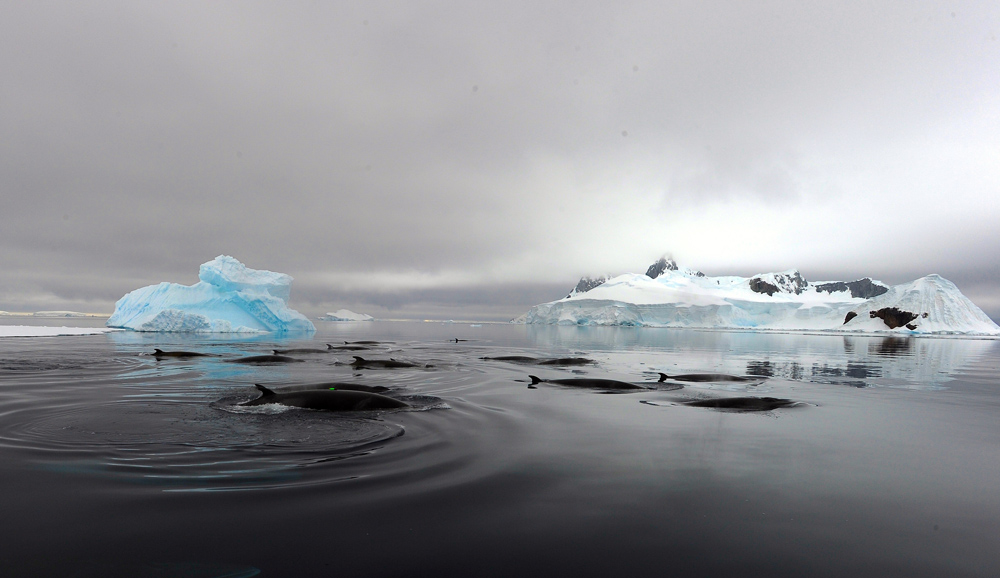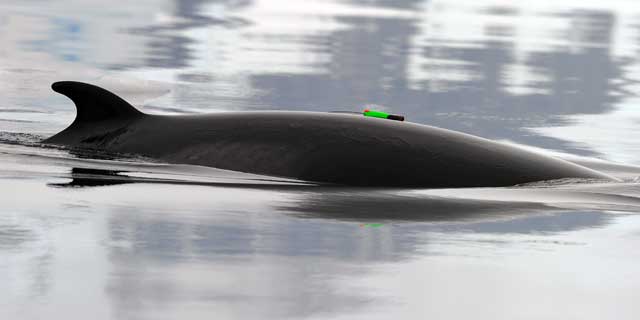|
Video Information
Scientists use a suction cup to humanely tag a minke whale. The NSF-funded research, which was conducted off the Antarctic Peninsula, was carried out under National Marine Fisheries Services permit 808-1735 and Antarctic Conservation Act permit 2009-014. Video courtesy of Ari Friedlaender.
A MouthfulMinke whales dive under sea ice to gobble up krill at unprecedented ratesPosted September 5, 2014
The first study to characterize the feeding behavior of minke whales The research, published in the The Journal of Experimental Biology, observed that Antarctic minke whales (Balaenoptera bonaerensis) will lunge after their prey as many as 24 times per dive, twice that of their baleen whale cousin, the humpback (Megaptera novaeangliae), and up to six times more than world’s largest animal, the blue whale (Balaenoptera musculus). “They lunge over 100 times an hour, almost once every 30 seconds,” said Ari Friedlaender Friedlaender is the newest co-principal investigator on the Palmer Long Term Ecological Research (LTER) Most of the work by Friedlaender and colleagues in the Antarctic has focused on the less-elusive and more abundant humpback whale, making new discoveries about its feeding and migratory behaviors. [See previous article — Delayed response: Humpback whales found to remain in Antarctic feeding grounds longer than expected.] However, during the 2012-2013 austral summer, scientists aboard the research vessel Point Sur chanced upon a pod of 35 to 40 minke whales in Wilhelmina Bay, a picturesque bay known for its humpback whale congregations, as well as large numbers of krill, seals and penguins. “We very rarely see these large groups, so we knew that this was an extraordinary case,” Friedlaender said. Scientists were able to maneuver a boat among the torpedo-shaped mammals, which appeared to be socializing during the encounter, and deploy tags that record information about their movements and underwater communications. One of the tags used is about the size of a paperback novel, with sensors and a hard drive. The instruments are capable of recording the animal’s acceleration, movement, heading and even vocalizations. The team ended up collecting nearly 30 hours of dive data, including 650 dives and nearly 3,000 feeding events. The team – including researchers from Stanford University, Duke University and the Australian Antarctic Division The minkes were observed swimming just beneath the surface of the water, feeding at an incredibly high rate, skimming the underside of the sea ice. “The whales were feeding just underneath the surface where the sea ice meets the water and where the krill were aggregating,” Friedlaender said. The observations are important information about the ecology of this little-understood predator in the Antarctic marine ecosystem. They’re also significant given the rapid warming underway along part of the Antarctic Peninsula, where subantarctic climate and species are migrating south. Sea ice, in particular, is virtually disappearing, with winter duration cut down by three months in some areas. “Sea ice in the area around the Antarctic Peninsula has decreased dramatically in the last 30 years,” Friedlaender noted. “Yet we do not know how critical the sea ice is as a habitat for the whales.” Friedlaender told Science news online that the noninvasive methods employed by his team demonstrate that culling animals for research, such as the controversial Japanese whaling program in the Southern Ocean, is not necessary. “We learned more in two weeks of studying these animals in the Antarctic than the Japanese have ever produced,” Friedlaender says. “There are ways to study these animals and their feeding behavior without taking them out of the picture.” NSF-funded research in this article: Ari Friedlaender, Douglas Nowacek and David Johnston, Duke University, Award No. 1250208 |



For USAP Participants |
For The Public |
For Researchers and EducatorsContact UsNational Science FoundationOffice of Polar Programs Geosciences Directorate 2415 Eisenhower Avenue, Suite W7100 Alexandria, VA 22314 Sign up for the NSF Office of Polar Programs newsletter and events. Feedback Form |




